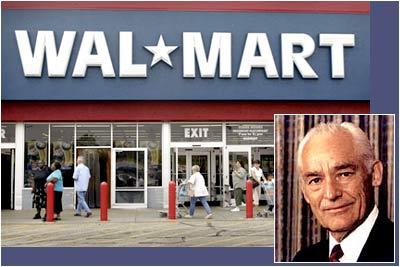 India's retail sector is really buzzing. A recent study says that over the next few years, 90 lakh (9 million) jobs will be created in this sector. The government is thus keen to provide a major thrust to the sector by easing foreign direct investment norms.
India's retail sector is really buzzing. A recent study says that over the next few years, 90 lakh (9 million) jobs will be created in this sector. The government is thus keen to provide a major thrust to the sector by easing foreign direct investment norms.
And major Indian corporates along with international giants are jumping into the fray to set up retail chains.
Close on the heels of Reliance launching its first retail store in Hyderabad recently, Sunil Mittal-led Bharti Enterprises has created a big splash by signing an agreement with the world's largest retailer Wal-Mart Stores to get in to the retail business.
So what is Wal-Mart? When was it set up? Who owns it? Read on to find out:
World's largest retailer
The world's largest retailer -- Wal-Mart Stores Inc -- began life in Rogers, Arkansas, USA, in 1962, when Sam Walton opened his first Wal-Mart discount store. Wal-Mart Stores became a full fledged corporation on October 31, 1969, and listed on the New York Stock Exchange in 1972.
After travelling through the United States, Sam Walton was convinced that the retailing concept would succeed. So along with his wife, Helen, he put up the money for the first Wal-Mart store in Rogers, Arkansas.
Sam Walton's career
Sam Walton's retailing career began when he accepted a job offer at a JC Penney store in Des Moines, Iowa on June 3, 1940 where he remained for eighteen months. In 1945, Walton met with Butler Brothers, a regional retailer that owned a chain of variety stores called Ben Franklin. Butler Brothers offered him a Ben Franklin store in Newport, Arkansas.
Walton could not come to agreement on his lease renewal and unable to find a new location in Newport; so he located a new variety store in Bentonville, Arkansas which he would open as another Ben Franklin franchise, but called 'Walton's Five and Dime.'
Today, his gamble has paid off in a big way. The company is a global giant with over 1.8 million associates worldwide and nearly 6,500 stores and wholesale clubs across 15 countries.
Sam Walton died on April 5, 1992 at the age of 74, after creating one of the biggest chains of discount stores in the world.
His widow Helen R Walton, daughter Alice L Walton, and sons Jim C Walton, John T Walton and S Robson Walton, each with a personal wealth in excess of $20 billion, have all been ranked among the richest Americans by Forbes for the past many years.
The Wal-Mart Web site quotes from Sam Walton's autobiography: "The secret of successful retailing is to give your customers what they want. And really, if you think about it from the point of view of the customer, you want everything: a wide assortment of good quality merchandise; the lowest possible prices; guaranteed satisfaction with what you buy; friendly, knowledgeable service; convenient hours; free parking; a pleasant shopping experience."
"You love it when you visit a store that somehow exceeds your expectations, and you hate it when a store inconveniences you, or gives you a hard time, or pretends you're invisible," Walton wrote.
The growth of Wal-Mart
Within five years the company expanded to 24 stores across the state of Arkansas and reached $12.6 million in sales.
In 1968 the company opened its first stores outside of Arkansas in Sikeston, Missouri and Claremore, Oklahoma. The company was incorporated as Wal-Mart Stores, Inc. on October 31, 1969, and in 1970, opened its home office in Bentonville, Arkansas, as well as its first distribution center.
There were now 38 stores operating with 1,500 employees and sales of $44.2 million. The company began trading stock at this time as a publicly held company on October 1, 1972, and was listed on the New York Stock Exchange shortly thereafter.
The first stock split occurred in May 1971 at a market price of $47. By this time, Wal-Mart was operating in five states: Arkansas, Kansas, Louisiana, Missouri and Oklahoma, and entered Tennessee in 1973, and Kentucky and Mississippi in 1974. As the company moved into Texas in 1975, there were 125 stores with 7,500 employees, and total sales of $340.3 million.
Wal-Mart grew rapidly during the 1980s and 1990s. In 2005, it was the world's second highest-grossing corporation.
While other discounters such as Kmart quickly expanded across the country in the 1960s, Sam was able to raise the funds to build only 15 Wal-Mart stores, says the company Web site.
Wal-Mart got the boost it needed in 1970, when its stock was offered for the first time on the New York Stock Exchange. The public offering created the capital infusion that grew the company to 276 stores by the end of the decade. By focussing on customer expectations, Wal-Mart was growing rapidly in 11 states.
In the 1980s, Wal-Mart became one of the most successful retailers in America. Sales grew to $26 billion by 1989, compared to $1 billion in 1980. Employment increased tenfold. At the end of the decade there were nearly 1,400 stores. Wal-Mart Stores, Inc. branched out into warehouse clubs with the first Sam's Club in 1983.
Current revenue
For the fiscal year ending January 31, 2006, Wal-Mart reported net income of $11.2 billion on $316 billion of sales revenue.
As of November 2, 2006, revenue was $26.7 billion higher than it was one year ago. It is the largest private employer in the United States and Mexico.
Wal-Mart is the largest grocery retailer in the United States, with an estimated 20 percent of the retail grocery and consumables business, and is also the largest toy seller in the United States, with an estimated 22 percent of the retail toy business, having surpassed Toys 'R' Us in the late 1990s.
As of October 31, 2006, there were 1,100 Wal-Mart Discount Stores in the United States. The busiest Wal-Mart in the world is in Southaven, Mississippi.
Wal-Mart, globally
Wal-Mart is a global giant with over 1.8 million associates worldwide and nearly 6,500 stores and wholesale clubs across 15 countries.
It operates in Mexico as Walmex, in the United Kingdom as ASDA and in Japan as The Seiyu Co Ltd.
The retailer's wholly owned operations are located in Argentina, Brazil, Canada, Puerto Rico, and the United Kingdom. Wal-Mart's investments beyond North America have produced mixed results. In 2006, Wal-Mart sold its retail operations in South Korea and Germany.
Criticism against Wal-Mart
Wal-Mart has been widely criticised for its policies and business practices by community groups, labour unions, religious bodies and even environmental groups. What has created a major controversy is Wal-Mart's philosophy of sourcing products from low-cost nations. Its handling of its employees and suppliers too has come under heavy censure. Also, it predatory attitude has caused havoc on the local economies of small towns.
Wal-Mart's arms
Wal-Mart's operations are comprised primarily in three retailing subsidiaries: Wal-Mart Stores Division US, Sam's Club, and Wal-Mart International.
Wal-Mart does business under nine different retail formats: supercenters, food and drugs, general merchandise stores, bodegas (small markets), cash and carry stores, membership warehouse clubs, apparel stores, soft discount stores and restaurants.
Wal-Mart board
Wal-Mart's board of directors has 13 members who are elected by shareholders every year. S Robson Walton, Sam Walton's eldest son, is the chairman of the board. H Lee Scott is the company's chief executive officer.
Also on the current Wal-Mart board are: Jim C Walton, Christopher Williams, Aida Alvarez, James Breyer, M Michele Burns, James Cash, Douglas Daft, David Glass, Roland Hernandez, Jack Shewmaker and Linda Wolf.
Photograph shows a Wal-Mart store in Riverside, Illinois, USA. (Inset) Wal-Mart founder Sam Walton.
Photo: Scott Olson/Getty Images.






 © 2025
© 2025